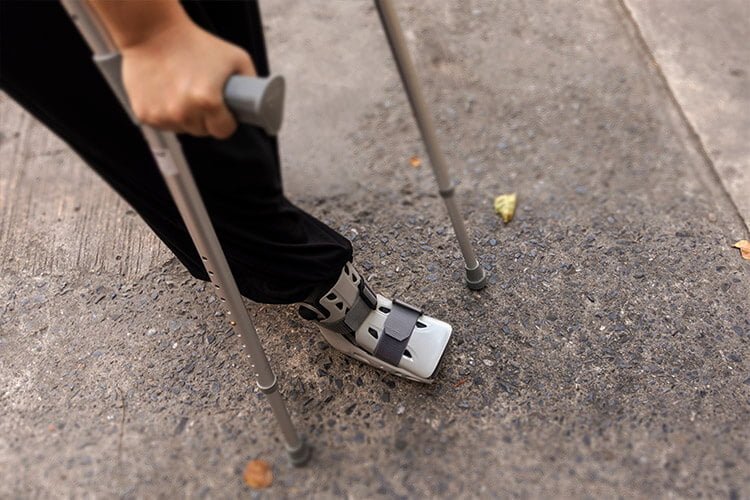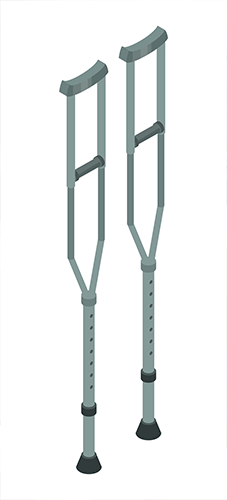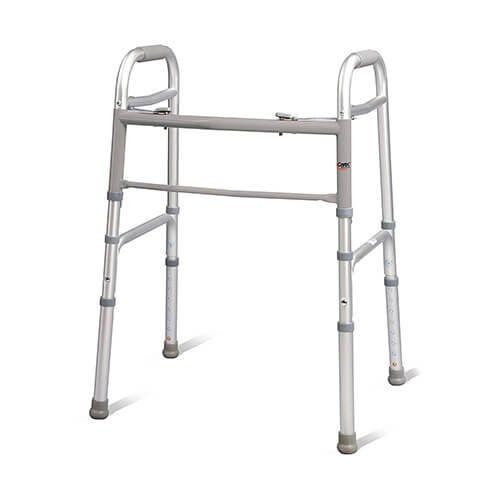- Sticks, Canes & Crutches
- Our Quality Guarantee
- Last Updated January 18, 2024

Do You Need Crutches with a Walking Boot?
A “walking boot”, also known as an “orthopedic shoe”, is a medical shoe designed to protect the foot. They are widely used by people recovering from an injury (or surgery) to their foot or ankle. The types of injuries they are primarily used for include sprains, tendon injuries, and even shin splints.
However, while a walking boot can provide stability and protection to facilitate healing, it is very rarely a good idea to use one as a real “boot” and to put weight on it. This is why most people who use a walking boot will use it alongside a pair of crutches.
Of course, not everyone wants to use crutches with their walking boot; they can be uncomfortable and a pain to carry around. This leads many to ask:
Do you actually need crutches with a walking boot?
The short answer is no: You don’t need crutches with a walking boot. While you shouldn’t generally put weight on a walking boot, other mobility aids can be used instead of crutches to prevent this from occurring. These include wheelchairs, canes, walkers, and others.
Of course, that’s only the short answer! In this article, we will explore these alternatives further and delve deeper into what your options are if you are using a walking boot. First, let’s deal with the basics:
In This Article
How a Medical Walking Boot Should Be Used
Before you even consider walking in your boot without crutches, you need to ensure you are using it properly.

The most important rule to ensure your comfort during recovery is that the shoe you are wearing on your “good” foot must be of roughly the same height as the walking boot. This will ensure that your body-weight is distributed evenly. Thankfully, some walking boots have adjustable heel lifts, which can help you out in this regard.
Moreover, it is necessary to use arch support inside the boot to stabilize your foot and prevent discomfort. This will create a smooth contact surface, which will decrease pain and promote healing.
Finally, you will also have to shorten your step with a walking boot, as they typically have a ‘Rocker’ Bottom. What this means is that you won’t be able to take as big steps as you can with regular shoes. Shortening your stride is also advised as it will prevent adding unneeded stress to your boot.
With these factors in mind, we can now move on to the role crutches play in relation to walking boots:
The Purpose of Crutches
Crutches are another prominent mobility aid. They are often used alone but tend to be suggested alongside a walking boot.

Crutches operate by transferring weight and pressure from the legs to the upper body, like a walking stick or cane.
Its design is based on that of a walking stick. It operates by transferring weight and pressure from the legs to the upper portion of the body. The users’ arms provide upper support.
The design of crutches has developed over the years, and as a result, many modern crutches have various enhanced features. For example, most modern crutches are height-adjustable:

There are four primary types of crutches. These are Elbow (Forearm Crutches), Axillary (Underarm Crutches), Triceps Crutches, and Platform Crutches. The materials used in making crutches include carbon fiber composites, thermoplastic, carbon polymers, glass, wood, and metal alloys. Crutches are almost always used in pairs for adequate support.
Using Crutches and Walking Boots Together
Crutches and walking boots often do go hand in hand with each other; they complement each other’s functions. Here’s a visual explanation:
For example, in the case of severe injury, crutches will allow you to take all the weight off your boot (and your foot!), and to relieve the pain.
One important thing to note is that crutches are meant to facilitate recovery and are not a permanent solution.
How to Walk in a Walking Boot Without Crutches
Some people do not prefer using crutches for various reasons, such as that they are uncomfortable or painful – this is caused by stress (i.e. your body-weight). Potential stress becomes an issue sometimes because crutches require a significant amount of upper-arm strength and chest muscle, which not everyone has!
Despite this, in many cases, it’s worth noting that as long as a patient does not ‘over-use’ or ‘under-use’ their crutches with a walking boot, they should recover without pain, just fine.
For the people that are still against crutches, an excellent alternative to using crutches with your walking boot is to use a cane instead!
How Canes Can Help
Canes are designed to be as comfortable as possible. A good cane provides the utmost stability and strength. There are a wide variety of canes available on the market that have innovative features.

These features ensure that your cane will provide sufficient traction, balance, and grip. Moreover, canes also have more sturdy handles and are lightweight compared to crutches. This makes them, generally, easier to move with.
A cane is a great mobility aid to use with a walking boot if you do not want to use crutches. But it all comes down to your preferences.
One important thing to note is that walking without crutches might cause some minor pain in the initial stages. But this should shortly wear off.
Using a Wheelchair or Walker With a Walking Boot Instead
A wheelchair is a very commonly used mobility aid device. No one needs to be told what one looks like!
A walker is another prominent mobility aid tool. It consists of a lightweight frame that is about waist high and is slightly wider than the width of the user. The user operates the walker by walking with the frame surrounding their sides and front and using their own hands to provide additional support. Movement is done by picking up the walker and placing it a short distance ahead.

Using a wheelchair or a walker with a walking boot is not that common – but it’s not a problem at all! In fact, there are some products available on the market that are a combination of walkers and wheelchairs, which assist users in performing their normal activities.
If you use a wheelchair or walker with a walking boot, you have no or little weight exerted on your foot. It also gives you the ability to elevate your foot. This is great in a way, as your potential pain and discomfort levels will be minimized. However, this will likely extend your recovery timeline as your foot will not be trained to resist and learn from mild pain. Moreover, wheelchairs and walkers are not cheap and generally cost more than walking boots and crutches.
In short: Wheelchairs and walkers can indeed be used with walking boots. However, their use is dependent upon the situation and the pain capacity of the user. If the user wants to opt for a gradual recovery and does not have a high pain capacity, walkers and wheelchairs are a good option, compared to crutches.
Conclusion
As the above demonstrates, there is no definite answer to the question: “Do you need Crutches With a Walking Boot?” It is highly dependent upon many factors. These factors include the extent of the injury, the strength, and the pain capacity of the patient.
But generally, they complement each other: The walking boot protects the injured foot from further damage and re-aligns it so that it can recover. Crutches prevent extra pressure and weight being added to the walking boot so that it can perform its function better.
Crutches are not the only mobility aid item that can be used with Walking Boots. Wheelchairs and Walkers are also viable alternatives. However, their use will be dictated by your finances and the situation of the user.
More Mobility Articles:
Articles You May be Interested In:


















